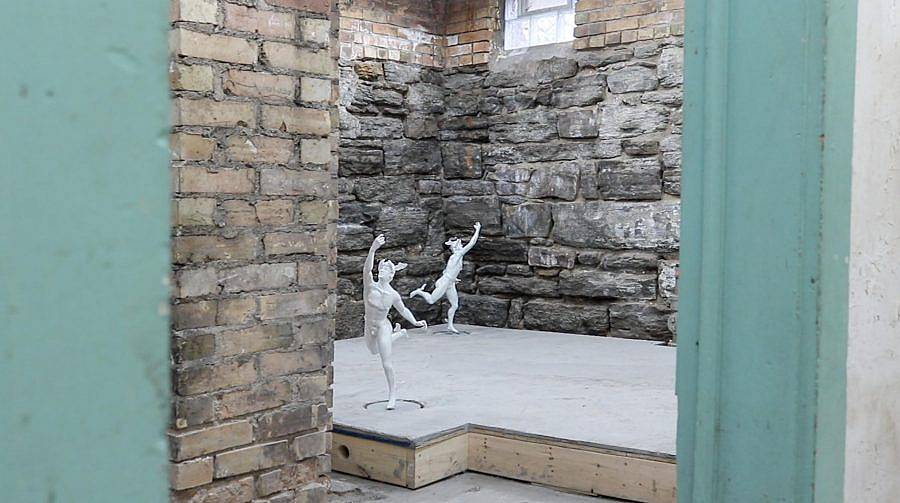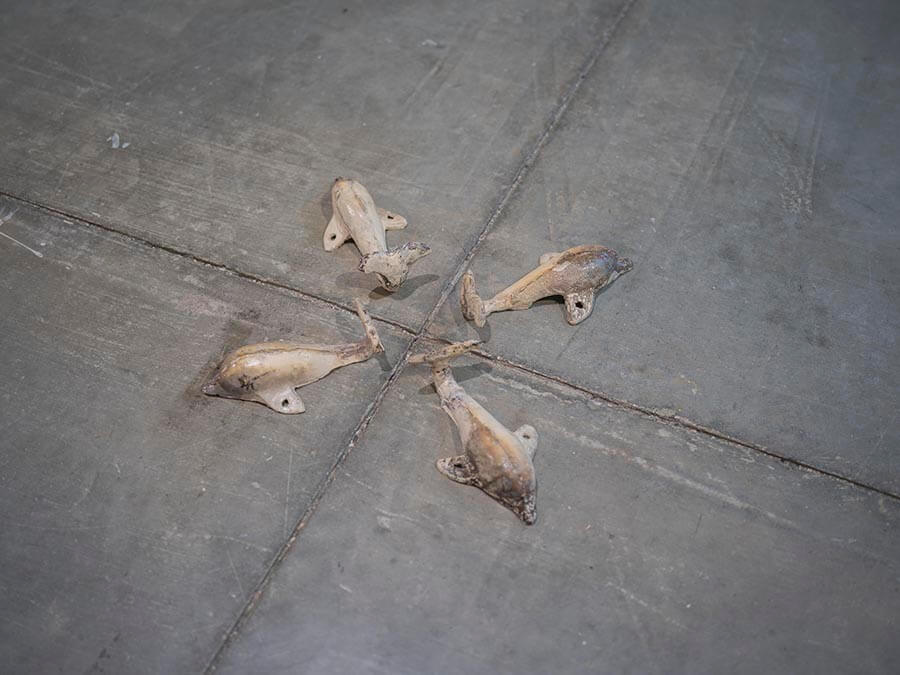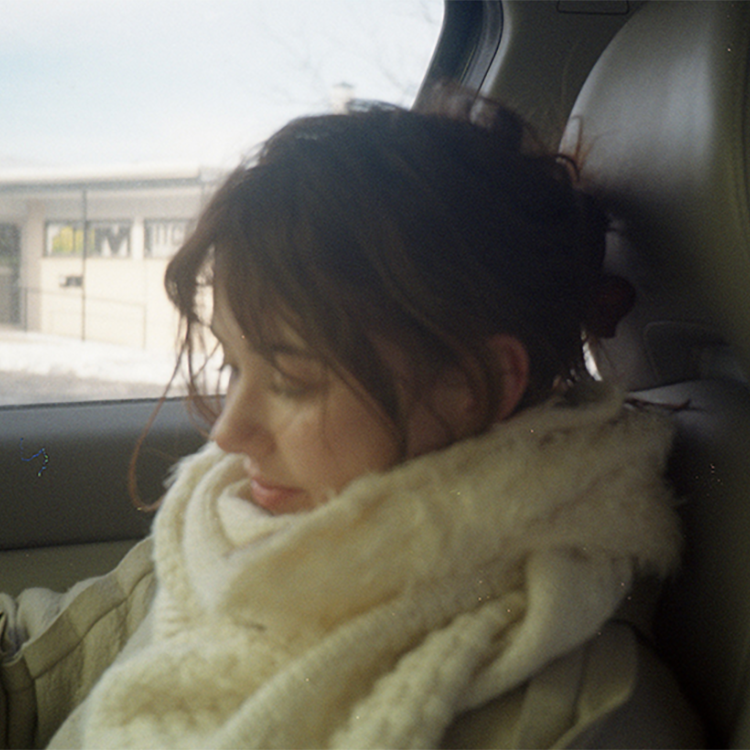Tell us a little about yourself and what you do.
I’m used to saying I’m a sculptor living and working in Minneapolis, but I actually moved to St. Paul on August 1st. I’m a sculptor living and working in St. Paul.
What made you want to be an artist and was creativity something that was valued in your household when you were growing up?
My Mom’s a really amazing painter and teaches drawing and painting at a university here in MN. She absolutely shaped my taste and my drive, but growing up I thought I would rebel against my parents by doing something else. It totally didn’t work, I just never called what I was making “art,” until college. I think I was scared of failure and not living up to how beautiful my Mom’s work is. I have a distinct memory of the moment I gave up on trying not to be an artist. It was 2016 I think and I was sitting by the duck pond in Loring Park. I listened to https://soundcloud.com/eande/irreducible-wing-silly-faggot-mix for the first time, it totally changed my life.

Can you talk a bit about your recent debut solo exhibition “Quicksilver” at Waiting Room in Minneapolis?
Quicksilver is an alchemical name given to the element mercury, its quick-to-change liquid form. Mercury the element is named for Mercury the Roman god, the only deity who can travel between the three realms of heaven, hell and earth freely. Mercury is the trickster who flips structures on their heads so we can see the underbelly. Kristina Johnson, director of Waiting Room, encouraged me to pull out the narrative undertones in my work, so I leaned into stories about Mercury.
I created a false concrete floor at Waiting Room and rigged up moving sculptures to dance on it. The double floor could reference an archaeological dig site, a stage, or a practical joke. I 3D printed two mercury statues from an open source STL file – a scan from a French bronze copy of an Italian marble copy of a Greek original bronze of Hermes (Mercury). They twist towards and away from each other slowly. https://vimeo.com/852177321?share=copy I built the rest of the show around that sculpture. I cast various fixtures, like pipe covers, nails, screws, and valves, from around Waiting Room, installing them in conversation with the space and with their original.

How would you describe your relationship with casting?
I value fluidity and transformation. I see casting as a really poignant gesture of transformation. Casting an object in a new material changes the identity of the object while the form remains the same. I’m interested in the significance of material choice in casting, but I think there’s also a lot to be uncovered in what stays the same about an object once it’s cast. To explore this I often cast objects in sort of oppositional materials (an iron nail cast in gold, for example) and put the cast back where I took the original object from. Through these subtle interventions I hope to reveal more about the contexts of the object and the space it exists in.
Casting is an ancient sculptural practice, which references the study of history by virtue of being the production method of many lasting objects from antiquity. Casting feels timeless in that sense, or rather bends time in a way that I find interesting. Casting is also used as a method of historic preservation. I’ve been thinking a lot recently about Pompeii, how plaster casts now replace corpses of the people who died there, put back on the ground in the same spot for the sake of preserving their bodies further.
Who has been inspiring you lately?
This is tough because I want to give you like a million names.
I’m reading Eros the Bittersweet by Anne Carson and her writing has become such a powerful influence in life and in the studio. My friend Julia Garcia (who also inspires me!) recommended it to me after Quicksilver. I’ve also been reading The History of Sexuality by Foucault with some friends lol.
This past year, I’ve been obsessed with the work of Gala Porras Kim. I think about her project Precipitation for an Arid Landscape all the time. I also loved the Chiquimamani-Condori installation at MOMA PS1, I’m so grateful I got to see that.
I have a good community right now. I especially look to my boyfriend Cade Duff and bestie Kevan McClafflin a lot for motivation and inspiration.

Could you talk about the ways in which your work approaches constructions of reality, history, and truth?
I’m fascinated by the impossibility of empirical history, the fallibility of memory, and the power and pitfalls in a collective deciding of truth.
Casting comes up again here too. An artist from town I admire put it astutely by comparing casting to photographic processes. There’s a loaded assumption that the method itself produces an inherently accurate reproduction or replication. Casting is the industrial production method of choice when it comes to maintaining accuracy and faithful replication of a pattern. I definitely want to reveal my hand in my casts. By sewing some subtle discordance in that assumption of accuracy I hope that the viewer might then start to notice and wonder about contexts that weren’t obvious before. I think some tricky placement or repetition or a really strange material choice can bring out different elements of a conversation about the politics, history, geography, etc. of an object in space.
Consider the role of archaeology, or generally the collection of evidence, as a stage for the fabrication and subsequent performance of reality. Recently, a friend of mine told me about a summer job he had when he was young: illustration of ancient artifacts. He was tasked to determine what an object would have looked like, as well as its use, based on his own interpretation of fragments found at an excavation site. His interpretations would be published in academic catalogs as the accurate former state of the object.
In this new arc of the information age, where we are bombarded by the pressure to choose an opinion or identity and stick to it, I think maintaining a politics of fluidity is crucial. I think queer theory is particularly relevant here. We are so determined in queer circles to self-identify and then prove our identity by never changing it – however I’m of the opinion that being so fixed is sort of antithetical to the queer project. I’m really attracted to Jose Esteban Munoz’s theory about queer potentiality – essentially that hope is resistance, imagination is resistance, that’s kind of the root I want my work to have. I want to embrace the shifting of truth, the shifting of reality, with the expectation that we will build a better future for ourselves if we can imagine one outside of the constraints of limitations we set for what’s possible.

How do you typically decide the scale of your work and what things do you consider when you are installing them in an exhibition space?
I’m still trying to figure that question out myself! I make a lot of small objects because it’s quick and easy, I can do it off the cuff which makes me happy. The bigger sculptures have been more difficult and planning-heavy but very fulfilling.
When I’m installing, I definitely try to find spots where the work will encourage attention to architectural details in the space that emphasize my concept (corner, light, window, crack on the floor, etc). I often start my process by spending time with the space I’m installing in, with an idea of where my work will go.
Much of your work is object-oriented, aside from your practice, how would you describe your relationship to the objects that you surround yourself with?
I’m really picky about the objects I surround myself with. I usually know what I like in an object right off the bat. I try not to have too much clutter but I also love shopping.

What do you feel is the importance of social media for the 21st century artist?
I appreciate being able to be introduced to a lot of new work via social media, and I LOVE getting to meet artists online. I’ve made some really good friends that way. Sometimes I like instagram reels. Social media mostly really really really stresses me out though. I feel pressure to post a lot to get myself out there, I think that’s expected of artists nowadays, but I rarely feel like I have a lot worth posting, or by the time I get a good pic of my work I don’t want to share it anymore. I’m grateful for the instagram archive feature.
Do you have any upcoming projects that you can share?
I have work in the Hole at Weatherproof in Chicago 9/7-9/24, and in a group show at Nightclub in Minneapolis which will open in late September. I’m currently planning with my friend Ellie Lizbeth Brown about a collaborative show at her gallery in Berlin, fingers crossed!
Interview conducted and edited by Sam Dybeck.
